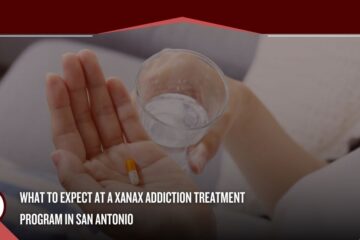At Alamo Behavioral Health, we frequently come across stories of individuals attempting to detox at home, a practice commonly known as DIY detox. Unfortunately, we have witnessed firsthand the detrimental impact that this approach can have on one’s health and well-being. We want to emphasize the risks of trying to detox at home and strongly discourage this potentially hazardous endeavor. As the drug and alcohol detox center Texas trusts, we feel obliged to explore this matter in some depth. We will delve into the specific risks involved, highlighting the importance of seeking professional help and providing insights into safer alternatives.
An Introduction to Detoxification
Detoxification, in the context of drug and alcohol abuse, refers to the process of eliminating harmful substances from the body. NCBI defines it as follows:
“Detoxification is a set of interventions aimed at managing acute intoxication and withdrawal. It denotes a clearing of toxins from the body of the patient who is acutely intoxicated and/or dependent on substances of abuse. Detoxification seeks to minimize the physical harm caused by the abuse of substances.”
In turn, it is a crucial step in overcoming substance abuse and embarking on the path to recovery.
When individuals become dependent on drugs or alcohol, their bodies adapt to the presence of these substances, leading to physical and psychological reliance. Detoxification serves as the initial phase of treatment, addressing the physiological aspect of addiction. By removing the toxic substances from the body, detoxification helps alleviate withdrawal symptoms, manage cravings, and stabilize the individual’s physical condition. It lays the foundation for further therapeutic interventions and allows individuals to engage more effectively in the recovery process.
That said, detoxification is best conducted under the supervision of medical professionals who can provide the necessary support and monitoring to ensure the individual’s safety and well-being. As we’ll see next, the risks of trying to detox at home are too many and too substantive to ignore.

Withdrawal During Detox
With the basic definition in order, withdrawal is another crucial term to introduce early. Before consulting with any drug detox center Texas has to offer, you should be aware of this aspect of detox.
Withdrawal is an inevitable and challenging aspect of the detoxification process. When individuals with substance dependence abruptly stop or significantly reduce their drug or alcohol intake, their bodies undergo a series of physiological and psychological changes. These changes, collectively known as withdrawal symptoms, occur as the body adjusts to functioning without the presence of the addictive substance.
Withdrawal can manifest in various ways, such as:
- intense cravings
- anxiety
- depression
- irritability
- nausea
- sweating
- tremors
- insomnia
The severity and duration of withdrawal symptoms depend on factors such as the substance used, the duration of use, the individual’s overall health, and their specific circumstances.
Withdrawal serves as an indicator of physical dependence and highlights the profound impact that substances have on the body. While withdrawal symptoms can be uncomfortable and distressing, they are an essential part of the detox process. Through a medically supervised detoxification program, healthcare professionals can provide appropriate interventions to manage and alleviate withdrawal symptoms, ensuring the individual’s safety and comfort.
Withdrawal Symptoms and Substance-Specific Withdrawals
Having highlighted the above, here we can begin to delve into specifics. Here the risks of trying to detox at home will start becoming apparent, starting with withdrawal symptoms themselves.
Withdrawal symptoms can and will vary, but many common ones can pose significant risks to the individual’s health. AAC lists the following as common withdrawal symptoms:
- Dilated pupils
- Trembling and tremors
- Muscle pain or aches
- Hunger or loss of appetite
- Fatigue
- Sweating
- Irritability and agitation
- Depression
- Anxiety
- Nausea
- Vomiting
- Confusion
- Insomnia
- Paranoia
- Seizures

In addition, different substances come with unique or stronger symptoms of their own. The most notable ones among them follow.
Alcohol
Alcohol withdrawal can lead to severe symptoms that pose significant risks to an individual’s health and well-being. Common withdrawal symptoms include:
- Tremors: Uncontrollable shaking, usually affecting the hands, arms, or legs.
- Delirium tremens (DTs): A severe form of alcohol withdrawal characterized by confusion, hallucinations, rapid heartbeat, and seizures.
- Anxiety and agitation: Intense feelings of restlessness, nervousness, and unease.
- Nausea and vomiting: Persistent stomach discomfort and the urge to vomit.
- Sweating and fever: Excessive sweating and a raised body temperature.
- Insomnia: Difficulty falling asleep or staying asleep.
- Elevated blood pressure and heart rate: Increased risk of cardiovascular complications.
These symptoms can have dangerous consequences, such as dehydration, malnutrition, seizures, and even life-threatening conditions like DTs. It is thus crucial to seek established alcohol detox Texas programs to mitigate the risks and ensure a safer detoxification process.
Benzodiazepines
Benzodiazepine withdrawal carries some of the most notable risks of trying to detox at home, as it can give rise to significant symptoms that carry inherent dangers. Common withdrawal symptoms include:
- Anxiety and panic attacks: Overwhelming feelings of fear and intense anxiety.
- Insomnia and sleep disturbances: Difficulty falling asleep or staying asleep.
- Seizures: Sudden electrical disturbances in the brain that can lead to convulsions.
- Irritability and agitation: Heightened restlessness and irritability.
- Muscle pain and stiffness: Aches, cramps, and tension in the muscles.
- Nausea and vomiting: Persistent stomach discomfort and the urge to vomit.
- Cognitive difficulties: Problems with concentration, memory, and cognitive function.
These symptoms can pose serious risks to an individual’s well-being, including the potential for seizures, severe psychological distress, and a rebound effect of heightened anxiety and insomnia. This is why most providers of benzo detox in Texas tailor their services to these inherent difficulties of benzo addiction.

Heroin
Heroin withdrawal also entails distressing symptoms that can pose significant dangers to individuals. Common withdrawal symptoms include:
- Intense cravings: Overwhelming desire to use heroin again.
- Flu-like symptoms: Body aches, fever, chills, and sweating.
- Nausea, vomiting, and diarrhea: Gastrointestinal distress and dehydration.
- Insomnia and sleep disturbances: Difficulty falling asleep or staying asleep.
- Anxiety and depression: Persistent feelings of fear, sadness, and hopelessness.
- Muscle and bone pain: Aches, cramps, and discomfort in the muscles and bones.
- Increased heart rate and blood pressure: Heightened risk of cardiovascular complications.
These symptoms can have severe consequences, such as dehydration, electrolyte imbalances, cardiovascular complications, and mental health issues. Heroin carries some of the most life-threatening risks of trying to detox at home, especially since lack of supervision can lead to relapse and overdoses. Programs for heroin detox in Texas are always the safer option to ensure the individual’s safety, minimize risks, and receive appropriate support and treatment to manage the symptoms effectively.
Cocaine
Similarly, cocaine withdrawal is accompanied by a range of symptoms that can be dangerous to individuals. Common withdrawal symptoms include:
- Fatigue and exhaustion: Overwhelming feelings of tiredness and low energy.
- Depression and mood swings: Persistent sadness, irritability, and emotional instability.
- Increased appetite and weight gain: Intense cravings for food and changes in body weight.
- Agitation and restlessness: Heightened feelings of unease and inability to relax.
- Intense drug cravings: Overwhelming desire to use cocaine again.
- Disturbed sleep patterns: Difficulty falling asleep or experiencing fragmented and disrupted sleep.
These symptoms can lead to serious risks, such as suicidal thoughts, increased vulnerability to relapse, and challenges in managing everyday responsibilities. It is thus extremely risky to attempt a DIY detox from cocaine, much like most opioids.

Methamphetamine
Lastly, methamphetamine withdrawal is also characterized by a range of symptoms that can pose significant dangers. Common withdrawal symptoms include:
- Intense cravings: Overwhelming desire to use methamphetamine again.
- Fatigue and lethargy: Persistent feelings of tiredness and lack of energy.
- Anxiety and paranoia: Heightened feelings of fear, worry, and suspiciousness.
- Depression and mood swings: Persistent sadness, irritability, and emotional instability.
- Disturbed sleep patterns: Difficulty falling asleep or experiencing fragmented and disrupted sleep.
- Increased appetite and weight gain: Strong cravings for food and potential changes in body weight.
These symptoms can lead to risks such as suicidal thoughts, increased susceptibility to relapse, and challenges in managing daily functioning. Therefore, opting for a meth detox Texas program over a DIY detox is strongly advisable.
DIY Detox and the Risks of Trying to Detox at Home
Having opposed DIY detox strongly so far, here we can delve deeper into its many risks.
First, engaging in DIY detox can significantly increase the risk of overdose. During detoxification, the body undergoes changes as it adjusts to the absence of the addictive substance. Without proper medical supervision, individuals may miscalculate the dosage needed to alleviate withdrawal symptoms, leading to relapse or accidental overdose.
WebMD summarizes this point by pinpointing the following shortcomings of home detox:
- Lack of professional guidance and supervision
- Inability to acquire detox medication
- Increased likelihood of relapse
- Higher chances of overdose
Moreover, DIY detox often lacks the necessary support and monitoring to ensure the individual’s safety and well-being during this vulnerable period. In contrast, supervised detox programs play a crucial role in minimizing overdose risks. In these programs, healthcare professionals closely monitor the individual’s progress, assess their physical and mental health, and provide appropriate interventions as needed. They can administer medications to alleviate withdrawal symptoms and reduce cravings, ensuring a safer and more comfortable detoxification process.
Additionally, supervised detox programs offer a supportive environment where individuals receive counseling, education, and emotional support, addressing the psychological aspects of addiction alongside the physical.
Dual Diagnosis and DIY Detox
The phenomenon of dual diagnosis carries great significance here. As it can also considerably exacerbate the risks of trying to detox at home, we should note it appropriately.
Dual diagnosis refers to the presence of both a substance use disorder and a mental health condition. In dual-diagnosis settings, individuals face the challenge of co-occurring mental health disorders alongside substance abuse. Unfortunately, NIDA finds it worryingly common; 37.9% of adults with SUDs also have mental illnesses. In addition, 18.2% of those with mental illness also have an SUD.
Naturally, engaging in DIY detox in these complex cases can exacerbate the risks associated with self-detoxification. Attempting DIY detox in this context can be even riskier due to the intricacies of managing withdrawal symptoms alongside complex mental health conditions. Potential complications can include heightened emotional distress, exacerbation of psychiatric symptoms, or increased risk of self-harm.
As such, we must strongly advise seeking the services of a dual diagnosis treatment center Texas has to offer. Professionals in such centers can provide appropriate medications, therapy, and counseling to address the interplay between substance abuse and mental health. They can offer specialized care that addresses both the substance abuse and the underlying mental health issues simultaneously, which is of paramount importance to ensure the individual’s safety.
What Does Professional Detox Involve?
With all of the above in order, we deeply understand that professional detox may sound intimidating. This is often why individuals opt for DIY detox, despite the risks of trying to detox at home. Therefore, here we can begin to outline the process and offer you some peace of mind.
Professional detox refers to the detoxification process conducted under the supervision of healthcare professionals in a structured and supportive environment. It involves:
- A comprehensive assessment of an individual’s physical and mental health
- The development of a personalized treatment plan
- The implementation of appropriate interventions to manage withdrawal symptoms and ensure the individual’s safety
Medical detox plays a vital role in the professional detoxification process. Medical detox programs in San Antonio provide specialized care that emphasizes the medical aspect of detoxification. They are staffed with experienced healthcare professionals who have expertise in addiction medicine and withdrawal management.

Medical detox programs offer 24/7 medical supervision, allowing for the close monitoring of vital signs, the administration of medications to alleviate withdrawal symptoms, and the management of any potential complications. This level of medical support significantly reduces the risks associated with detoxification, such as seizures, cardiovascular issues, or severe psychological distress.
Additionally, medical detox programs in San Antonio often incorporate a multidisciplinary approach, combining medical care with counseling, therapy, and educational resources to address the psychological, emotional, and social aspects of addiction.
Professional Detox Programs, Step By Step
Should you seek services for a medical detox in San Antonio specifically, we can also analyze how we and our peers approach the process. The detox process typically consists of three stages.
The first stage is the evaluation stage, where healthcare professionals conduct a comprehensive assessment of the individual’s physical and mental health. This involves gathering medical history, evaluating the severity of substance abuse, and identifying any co-occurring disorders. This phase helps avoid the risks of trying to detox at home in a safe and thorough way.
The second stage is the stabilization stage, where the individual undergoes the actual detoxification process. During this stage, medical professionals closely monitor the individual’s vital signs, administer medications to manage withdrawal symptoms, and provide support to alleviate discomfort. The duration and intensity of this stage vary depending on factors such as the substance used, the duration of use, and the individual’s overall health.
The third stage is the transition stage, where the individual begins to transition into further treatment. This may involve referrals to residential or outpatient treatment programs, therapy sessions, support groups, or other appropriate resources.
Throughout each stage, individuals can expect to receive personalized care, including medical supervision, counseling, and emotional support. The goal of professional detox programs is to provide a safe and comfortable environment for individuals to undergo the detoxification process while preparing them for ongoing treatment and recovery.

General Guidelines for Safe Detoxification
Beyond the fundamentals of each program, safe detoxification requires adherence to general guidelines to ensure the well-being of individuals seeking to overcome substance abuse.
Firstly, it is crucial to seek professional help and undergo detoxification under the supervision of healthcare professionals. They can provide medical monitoring, administer appropriate medications, and address any complications that may arise, preventing the risks of trying to detox at home.
Secondly, it is important to be honest and transparent about one’s substance use history, as this information is vital for developing an effective detox plan. A personalized detox plan is crucial because it takes into account an individual’s unique needs, medical history, and the specific substance(s) being used. This personalized approach allows healthcare professionals to tailor interventions and medications to manage withdrawal symptoms more effectively.
Furthermore, during detoxification, it is essential to prioritize self-care, including staying hydrated, getting adequate rest, and engaging in activities that promote relaxation and emotional well-being.
Additionally, having a strong support system, including family, friends, or support groups, can provide invaluable encouragement and accountability during the detox process.
Lastly, maintaining open communication with healthcare professionals and following their guidance is essential to ensure a safe and successful detoxification experience.
By adhering to these general guidelines and working closely with professionals, individuals can embark on a detoxification journey that prioritizes their safety, comfort, and long-term recovery.

Managing Withdrawal Symptoms During Detox
Managing withdrawal symptoms during detoxification is essential for a more comfortable and successful recovery journey. While your treatment providers will help you every step of the way, here are some tips to help individuals navigate the challenges of withdrawal:
- Stay hydrated: Drink plenty of fluids, such as water or herbal tea, to prevent dehydration and flush toxins from the body.
- Maintain a balanced diet: Eat nutritious meals that include fruits, vegetables, whole grains, and lean proteins to support the body’s healing process.
- Practice relaxation techniques: Engage in activities like deep breathing, meditation, or yoga to reduce stress and promote a sense of calm.
- Get regular exercise: Engaging in light to moderate physical activity, such as walking or gentle stretching, can help alleviate withdrawal symptoms and improve mood.
- Seek emotional support: Reach out to loved ones, support groups, or therapists to share experiences, seek guidance, and receive encouragement throughout the detox process.
- Follow medical guidance: Take prescribed medications as directed by healthcare professionals to manage specific withdrawal symptoms and minimize discomfort.
- Create a structured routine: Establish a daily schedule that includes regular mealtimes, sleep patterns, and engaging in meaningful activities to maintain a sense of stability and purpose.
- Avoid triggers: Steer clear of people, places, or situations associated with substance use to reduce the risk of relapse and maintain focus on recovery.
- Practice self-care: Engage in activities that promote self-care, such as taking warm baths, listening to soothing music, or engaging in hobbies that bring joy and relaxation.
Remember, every individual’s experience with withdrawal is unique, and what works for one person may not work for another. It’s important to communicate openly with healthcare professionals, follow their guidance, and be patient and kind to oneself during the detoxification process.

The duration and intensity of side effects can vary widely. Some individuals may experience mild symptoms that resolve within a few days, while others may experience more severe and prolonged effects that can last weeks or months.
Post-Detox Changes – Physical, Psychological, and Emotional
Equally notable, even successful detox can present some challenges. After detoxification, individuals experience various physical, psychological, and emotional changes as they begin their recovery journey.
Physically, they may notice improvements in energy levels, sleep patterns, and overall physical health as their bodies regain balance. Mentally and emotionally, individuals often experience increased clarity, improved mood stability, and a greater sense of self-awareness. Having overcome the risks of trying to detox at home, individuals start to address underlying emotional issues, such as traumatic past, and develop healthier coping mechanisms.
However, it is important to recognize that detoxification alone is not a comprehensive treatment for addiction. Ongoing treatment and support are crucial for sustained recovery. Continued therapy, counseling, or participation in support groups help individuals address the root causes of their addiction, develop relapse prevention strategies, and enhance their overall well-being. Ongoing support provides the tools and resources needed to navigate life challenges and maintain sobriety.

Warning Signs That Detox is Necessary
Recognizing the warning signs that detoxification is necessary is crucial for individuals struggling with substance abuse. Recognizing the warning signs and seeking professional advice promptly can significantly improve the chances of a successful detoxification process and pave the way toward long-term sobriety.
Indicators that suggest the need for detox include:
- Experiencing severe withdrawal symptoms when attempting to quit or cut back on substance use, such as tremors, hallucinations, or seizures
- Developing increased tolerance to the substance, leading to higher doses for the same effect
- Engaging in risky behavior, neglecting responsibilities, or experiencing deteriorating physical and mental health
If you or your loved ones suspect an imminent need to detox, we must strongly discourage you from opting for DIY detox.

Avoid the Risks of Trying to Detox at Home with Alamo Behavioral Health
The risks of trying to detox at home include potential complications, inadequate management of withdrawal symptoms, and an increased risk of relapse or overdose. As such, attempting to detox at home poses significant risks to individuals seeking to overcome substance abuse.
At Alamo Behavioral Health, we understand the importance of professional detox programs in providing the necessary support, guidance, and medical supervision. Our safe and effective detox programs are designed to address the unique needs of individuals and ensure their well-being throughout the detoxification journey.
It is our commitment to prioritize the safety and success of each individual’s detoxification process, empowering them to embark on a path of recovery with the necessary support and tools for lasting sobriety. If you need help or your loved ones are in need of such services, we hope we have offered you some peace of mind and reassurance.
If you wish to know more about us or our services, please feel free to contact us today. Learn how we can help you heal and regain control of your life.





